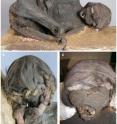Impact on mummy skull suggests murder
Blunt force trauma to the skull of a mummy with signs of Chagas disease may support homicide as cause of death, which is similar to previously described South American mummies, according to a study published February 26, 2014 in PLOS ONE by Stephanie Panzer from Trauma Center Murau, Germany, and colleagues, a study that has been directed by the paleopathologist Andreas Nerlich from Munich University. For over a hundred years, the unidentified mummy has been housed in the Bavarian State Archeological Collection in Germany. To better understand its origin and life history, scientists examined the skeleton, organs, and ancient DNA using a myriad of techniques: anthropological investigation, a complete body CT scan, isotope analysis, tissue histology, molecular identification of ancient parasitic DNA, and forensic injury reconstruction.
Radiocarbon dated to around 1450 -- 1640 AD, skeletal examination indicated that the mummy was likely 20-25 years old at the time of her death, and her skull exhibits typical Incan-type skull formations. Fiber from her hair bands appear to originate from South American llama or alpaca. Isotope analysis of nitrogen and carbon in her hair reveal a diet likely comprising maize and seafood, which, along with other evidence suggest South American origin and a life spent in coastal Peru or Chile.
The mummy also showed significant thickening of the heart, intestines, and the rectum, features typically associated with chronic Chagas disease, a tropical parasitic infection. DNA analysis of parasites found in rectum tissue samples also support chronic Chagas disease, a condition she probably had since early infancy. The skull structure where a massive skull and face trauma occurred, suggests the trauma was acquired prior to death, and indicates massive central blunt force. The young Incan may have been victim of a ritual homicide, as has been observed in other South American mummies.
Source: PLOS
Other sources
- Mummy Murder Mystery: Inca Woman Victim of Foul Playfrom MSNBC: ScienceThu, 27 Feb 2014, 16:30:48 UTC
- Impact on mummy skull suggests murderfrom Science DailyThu, 27 Feb 2014, 14:01:12 UTC
- Mysterious mummy ritually sacrificedfrom BBC News: Science & NatureThu, 27 Feb 2014, 10:50:13 UTC
- Mummy Murder Mystery: Incan Woman Victim of Foul Playfrom MSNBC: ScienceThu, 27 Feb 2014, 0:20:19 UTC
- ScienceShot: Mystery Mummy Was Ritually Murderedfrom Science NOWWed, 26 Feb 2014, 22:40:09 UTC
- In Images: The Mummy of A Murdered Incan Womanfrom Live ScienceWed, 26 Feb 2014, 22:20:24 UTC
- Mummy Murder Mystery Solved: Incan Woman's Head Smashedfrom Live ScienceWed, 26 Feb 2014, 22:20:23 UTC
- Impact on mummy skull suggests murderfrom PhysorgWed, 26 Feb 2014, 22:20:10 UTC
